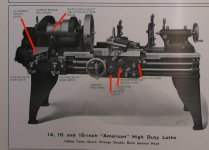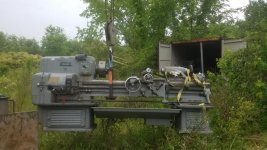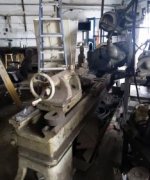How to install the app on iOS
Follow along with the video below to see how to install our site as a web app on your home screen.
Note: This feature may not be available in some browsers.
You are using an out of date browser. It may not display this or other websites correctly.
You should upgrade or use an alternative browser.
You should upgrade or use an alternative browser.
How much does this lathe weigh?
- Thread starter FiveO-Fab
- Start date
- Replies 14
- Views 5,850
gmach10
Hot Rolled
- Joined
- Dec 27, 2008
- Location
- N.E. Illinois
You're going to have to be a bit more specific with the machine description. Geared head, belt drive, etc. Right front corner of the machine below the front vee way is a stamped number. Get it post it and someone should be able to give you an answer. Right now you're saying, "I bought a Buick, how much does it weigh." Is it a 1949 or a 2018? Just my 2 cents.
Ferroequinologis
Plastic
- Joined
- Apr 17, 2020
johnoder
Diamond
- Joined
- Jul 16, 2004
- Location
- Houston, TX USA
Good point. I looked all over that machine for a model/serial number and couldn’t find squat. It’s located a good distance from me so won’t have a chance to get #’s. It’s a belt drive with, what I believe to be, a 5 hp motor.
Posting photos
https://www.practicalmachinist.com/...res-south-bend-forum-372508/?highlight=photos
Its competitor (belt drive but geared head) - made in the same town - weighed 3500 with six foot bed and 3850 with eight foot bed like here
1920 Lodge and Shipley 18" selective head
Paolo_MD
Stainless
- Joined
- Apr 6, 2013
- Location
- Damascus, MD
I would say definitely not more than 4000.
When you move it, I strongly suggest you remove the overhead motor first. If this is not an option, at least widen the base by bolting the longest pieces of 4x4s that will allow to go through any door/opening to both headstock and tailstock legs, and connect them with 4x4s or 4x6s protruding beyond the headstock. Roll this assembly on pipes (3/4" EMT is great if the floor is flat and smooth, larger diameter is it's rougher).
Paolo
When you move it, I strongly suggest you remove the overhead motor first. If this is not an option, at least widen the base by bolting the longest pieces of 4x4s that will allow to go through any door/opening to both headstock and tailstock legs, and connect them with 4x4s or 4x6s protruding beyond the headstock. Roll this assembly on pipes (3/4" EMT is great if the floor is flat and smooth, larger diameter is it's rougher).
Paolo
johnoder
Diamond
- Joined
- Jul 16, 2004
- Location
- Houston, TX USA
ATW did not publish weights in this 100 plus year old pub - thanks to Greg Menke for hosting this
http://pounceatron.dreamhosters.com/docs/atw/atw-efficiency-bulletin-1919-si.pdf
good luck - it has all the oldie attributes
Plain bronze or Babbitt style spindle bearings, (that never go very fast) - dozens of places to oil it - which all goes on the floor - and very likely no sort of "manual", ever
If you do need to know something about running OLD lathes, this will be hard to beat. Yours is just bigger, heavier and more capable of ruining your body parts
http://vintagemachinery.org/pubs/1617/5795.pdf
A good read
Serial is on front VERTICAL face of front way on right end - same as this fancy Pacemaker. Yours likely to be just five digits and nothing else

The lever sticking up on front of your head stock says you have double back gears - two ranges of SLOWER spindle speeds
http://pounceatron.dreamhosters.com/docs/atw/atw-efficiency-bulletin-1919-si.pdf
good luck - it has all the oldie attributes
Plain bronze or Babbitt style spindle bearings, (that never go very fast) - dozens of places to oil it - which all goes on the floor - and very likely no sort of "manual", ever
If you do need to know something about running OLD lathes, this will be hard to beat. Yours is just bigger, heavier and more capable of ruining your body parts
http://vintagemachinery.org/pubs/1617/5795.pdf
A good read
Serial is on front VERTICAL face of front way on right end - same as this fancy Pacemaker. Yours likely to be just five digits and nothing else

The lever sticking up on front of your head stock says you have double back gears - two ranges of SLOWER spindle speeds
Went and picked it up today. Was able to bribe the neighboring business to borrow a forklift. A couple guys had to get on the back to add more counterweight though. Everything went well until I ran into a severe thunderstorm on the way home. Got it a little wet but not too concerned because it's covered in about 40 years of oil and grease. I'll throw up some photos when I get a chance to mess around with it. Also, wish there was some sort of a manual to help figure out all the levers. Thanks for all the help/advice! Very much appreciated.
Andy
Andy
johnoder
Diamond
- Joined
- Jul 16, 2004
- Location
- Houston, TX USA
Here are some of the levers. I'll suppose the one I left out to right of QC selects between feed rod or lead screw. I'll add that the feed reverse has a NEUTRAL that you park it in when cutting threads using the lead screw.
The CHART that I refer to twice is the elegant bronze affair riveted on to the upper portion of the QC gear box

ON EDIT
Here is a 16" CHART - yours may be somewhat different - you can see the ABCD at the right, and the rows and columns show you what threads can be cut, and the corresponding feeds in turns per inch. Modern machines express feed in amount of inches per revolution of chuck. An example here is the 20 and the 80 - the 20 being threads per inch and the corresponding feed is 80 turns per inch - meaning the feed gearing in the carriage apron has a 4 to 1 ratio - at least for the longitudinal feed
To convert turns per inch to inches per revolution, just take the reciprocal - like 1/80 = .0125"

Greg Menke happened to have this on the 1913 18"
http://pounceatron.dreamhosters.com/docs/atw/atw-highduty-lathe-18in-1913-hagley.pdf
ph
The CHART that I refer to twice is the elegant bronze affair riveted on to the upper portion of the QC gear box

ON EDIT
Here is a 16" CHART - yours may be somewhat different - you can see the ABCD at the right, and the rows and columns show you what threads can be cut, and the corresponding feeds in turns per inch. Modern machines express feed in amount of inches per revolution of chuck. An example here is the 20 and the 80 - the 20 being threads per inch and the corresponding feed is 80 turns per inch - meaning the feed gearing in the carriage apron has a 4 to 1 ratio - at least for the longitudinal feed
To convert turns per inch to inches per revolution, just take the reciprocal - like 1/80 = .0125"

Greg Menke happened to have this on the 1913 18"
http://pounceatron.dreamhosters.com/docs/atw/atw-highduty-lathe-18in-1913-hagley.pdf
ph
Went and picked it up today. Was able to bribe the neighboring business to borrow a forklift. A couple guys had to get on the back to add more counterweight though. Everything went well until I ran into a severe thunderstorm on the way home. Got it a little wet but not too concerned because it's covered in about 40 years of oil and grease. I'll throw up some photos when I get a chance to mess around with it. Also, wish there was some sort of a manual to help figure out all the levers. Thanks for all the help/advice! Very much appreciated.
Andy
Last edited:
Greg Menke
Diamond
- Joined
- Feb 22, 2004
- Location
- Baltimore, MD, USA
Its a pre 1920's High Duty, double back gear headstock. Concur with Paolo wrt removing the motor and whatever else you might get off the headstock before you start humping it around. The lathe should balance pretty well front to back, but it still is top-heavy. The headstock is easily removed if you have a shop-crane handy, it will sure help moving the machine around.
If you read up on the South Bend how-to-run-a-lathe doc, the machine controls will be obvious. I had a 14" ATW of similar vintage circa 1912, later upgraded to a 1936 12" in much better condition.
A few years ago I looked over a 14" ATW with a motor mount similar to the one pictured, it looked like an effective setup.
If you read up on the South Bend how-to-run-a-lathe doc, the machine controls will be obvious. I had a 14" ATW of similar vintage circa 1912, later upgraded to a 1936 12" in much better condition.
A few years ago I looked over a 14" ATW with a motor mount similar to the one pictured, it looked like an effective setup.
thermite
Diamond
- Joined
- Sep 21, 2011
Also, wish there was some sort of a manual to help figure out all the levers.
Jr. HS shop had SB's "HTRAL", tail-end of the 1950's. @las M6 6" X 18" had a parts catalog.
Next manual I laid eyeball one was for the 1942 10EE. Parts book, mostly. Then the 1970's Cazeneuve HBX-360-BC. Installation, repair, and parts, mostly. Good manual, actually.
"HTRAL" is the only one as told yah what you could DO with a lathe. Got more - in me old age. Got the money to buy books now. We didn't so much, back then.
In between? Well there's a parallel universe...We trained Lootenents to never, EVER tell a Sergeant HOW to do anything.... unless you planned to spend every MINUTE of yer SHORTENED life, thereafter telling ALL Sergeants how to do EVERYTHING. I did say "shortened?"
Our foremen took the same view of card-carrying Union Machinists.
Told us which machine was "our mount", that shift. Handed us a blueprint and a punch-card to draw job-specific tooling against over to the toolcrib.
If you were far-enough along to even get hired-on? And still couldn't sort the levers first-sight of an unfamilar machine-tool just by walking up to it, hand turning a few things experimentally - running power traverse and/or any "rapids" in empty air where data plates were gone? Getting the job DONE?
You failed "probation". Some other guy could soon be hired-on as could do.
Shop had over a dozen lathes alone. No two alike. Nuthin' special. Just the way it was.
You either understood machinery. Or weren't even safe to trust under-roof not to get other folks bad-hurt.
The lathe you have is dirt-simple.
USE of it without reducing your corpse's body-mass, can be studied-up-on as "general information" ... applicable to ALL lathes in particular, and machine-tools, in general.
The rest? Sits right there under your hot hands as a full-scale "3D" working model"!
How hard can that be?

The "use of" lore is not "maker specific", and was never.
The tasking, alloy, workholding, tooling, and power available set those parameters.
Your job is to set up and operate any available lathe to actually deliver what the job needs done.
Same as they tell a PILOT IN COMMAND - no accident, that title - about the airplane under his ass.
It makes a marvelous servant. And a damned poor master.
IOW.. you shall have to do ALL the "heavy thinking" for that lathe. It can do NONE!
Just indifferently try to maim of even kill you.. ever you forget that.
johnoder
Diamond
- Joined
- Jul 16, 2004
- Location
- Houston, TX USA
More on back gears. Same 16" with the chart above.
Here is the back - with big lever in that attitude, the back gears are disengaged - meaning the spindle is "running open belt" in the three highest speeds.

Here is that end. In this view on the right we can again see the front lever that selects between the two back gear ratios - for two additional lower ranges of three speeds each. Interesting comparing your 18" and this 16" with the 18" in the brochure linked above (bottom of Post #10) - which has this selecting lever on TOP instead of on the front - as of 1913

Here is the back - with big lever in that attitude, the back gears are disengaged - meaning the spindle is "running open belt" in the three highest speeds.

Here is that end. In this view on the right we can again see the front lever that selects between the two back gear ratios - for two additional lower ranges of three speeds each. Interesting comparing your 18" and this 16" with the 18" in the brochure linked above (bottom of Post #10) - which has this selecting lever on TOP instead of on the front - as of 1913

Greg Menke
Diamond
- Joined
- Feb 22, 2004
- Location
- Baltimore, MD, USA
A small detail easily missed on these machines is the journals upon which the quandrant gears run are drilled axially, the hole leading to an oil port out on the journal surface. The operator can squirt some oil in to lubricate the gears. The red one John pictured might have OEM plugs in place. I put gits elbow oilers in them on my 1912 machine, but found that the typical converted grease-gun pumps oil into them more effectively so leave them open now.
Fairly important to do since otherwise the quadrant gears tend to run dry, particularly if the cover is in place and they are out-of-sight out-of-mind. My 1936 ATW had gone thru at least a set of the upper gears, the old worn out ones being in the pile of stuff that came with. Such wear affects the journals too, contributing to geartrain noise.
Fairly important to do since otherwise the quadrant gears tend to run dry, particularly if the cover is in place and they are out-of-sight out-of-mind. My 1936 ATW had gone thru at least a set of the upper gears, the old worn out ones being in the pile of stuff that came with. Such wear affects the journals too, contributing to geartrain noise.
Jr. HS shop had SB's "HTRAL", tail-end of the 1950's. @las M6 6" X 18" had a parts catalog.
Next manual I laid eyeball one was for the 1942 10EE. Parts book, mostly. Then the 1970's Cazeneuve HBX-360-BC. Installation, repair, and parts, mostly. Good manual, actually.
"HTRAL" is the only one as told yah what you could DO with a lathe. Got more - in me old age. Got the money to buy books now. We didn't so much, back then.
In between? Well there's a parallel universe...We trained Lootenents to never, EVER tell a Sergeant HOW to do anything.... unless you planned to spend every MINUTE of yer SHORTENED life, thereafter telling ALL Sergeants how to do EVERYTHING. I did say "shortened?"
Our foremen took the same view of card-carrying Union Machinists.
Told us which machine was "our mount", that shift. Handed us a blueprint and a punch-card to draw job-specific tooling against over to the toolcrib.
If you were far-enough along to even get hired-on? And still couldn't sort the levers first-sight of an unfamilar machine-tool just by walking up to it, hand turning a few things experimentally - running power traverse and/or any "rapids" in empty air where data plates were gone? Getting the job DONE?
You failed "probation". Some other guy could soon be hired-on as could do.
Shop had over a dozen lathes alone. No two alike. Nuthin' special. Just the way it was.
You either understood machinery. Or weren't even safe to trust under-roof not to get other folks bad-hurt.
The lathe you have is dirt-simple.
USE of it without reducing your corpse's body-mass, can be studied-up-on as "general information" ... applicable to ALL lathes in particular, and machine-tools, in general.
The rest? Sits right there under your hot hands as a full-scale "3D" working model"!
How hard can that be?
The "use of" lore is not "maker specific", and was never.
The tasking, alloy, workholding, tooling, and power available set those parameters.
Your job is to set up and operate any available lathe to actually deliver what the job needs done.
Same as they tell a PILOT IN COMMAND - no accident, that title - about the airplane under his ass.
It makes a marvelous servant. And a damned poor master.
IOW.. you shall have to do ALL the "heavy thinking" for that lathe. It can do NONE!
Just indifferently try to maim of even kill you.. ever you forget that.
Thank you for the reality check. I've fallen victim to the "I want easy answers now" without doing some research, or using my brain, to find answers mentality-- that in most cases right in front of my face. Enjoyed your reply.
Andy
Similar threads
- Replies
- 13
- Views
- 985




